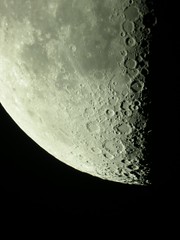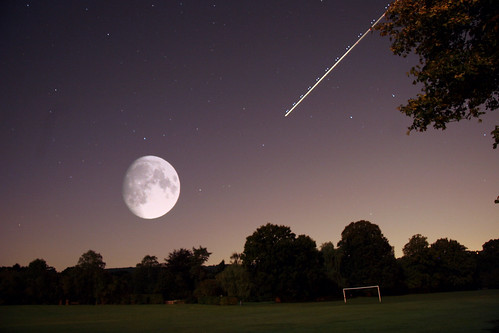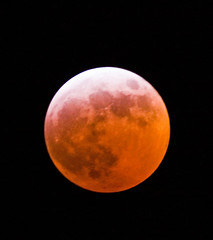Occurs a few times w/planets Venus & Jupiter with our moon to form a 'Smile face.' Next time to view such a planetary formation is Nov. 18th 2052!
Monday, December 1, 2008
Monday, November 24, 2008
Tuesday, November 11, 2008
Orion Nebula
The Orion Nebula is one of the most scrutinized and photographed objects in the night sky, by beginners in Astronomy as well as professionals in the field. That's because the Orion Nebula has revealed much about the process of how stars and planetary systems are formed from collapsing clouds of gas and dust. Astronomers and beginners have directly observed protoplanetary disks, brown dwarfs, intense and turbulent motions of the gas, and the photo-ionizing effects of massive nearby stars in the Orion Nebula.
Sunday, September 21, 2008
Harvest Moon
There's been a harvest moon recently, followed by a strange first quarter that puzzled some amateur astronomers but it's perfectly normal for this time of year.
Thursday, July 31, 2008
Total Eclipse August 1st
The total eclipse of the Sun tomorrow will only be visible to those who can be in the arctic circle more or less, but look back here afterwards for some stunning pictures of the Solar eclipse
Labels:
arctic,
eclipse,
solar,
sun,
Total Lunar eclipse
Sunday, July 20, 2008
South side of the Moon with named craters
Showing the craters of Ptolemaeus, Alphonsus, Arzachel, Rupes recta (the right wall), Bullialdus, Regiomontanus, Hell, Walter, Tycho, Maginus and Moretus. You might have to click though to the Sud de la Lune ( South of the Moon ) photo on Flickr to see the individual craters named with notes.
Wednesday, July 2, 2008
Friday, June 20, 2008
Sunday, May 11, 2008
THEOPHILUS
THEOPHILUS.--The most northerly of three of the noblest ring-mountains on the visible surface of the moon, situated on the N.W. side of the Mare Nectaris. It is nearly 64 miles in diameter, and is enclosed by a mighty rampart towering above the floor at one peak on the E. to the height of 18,000 feet, and at two other peaks on the opposite side to nearly 16,000 and 14,000. The border, though appearing nearly circular with low powers, is seen, under greater magnification, to be made up of several more or less linear sections, which give it a polygonal outline. It is prominently terraced within, the loftier terraces on the E. rising nearly to the height of the crest of the wall, and including several craters and elongated depressions. On the E. glacis is a row of large inosculating craters; and near its foot, S.W. of Madler, a short unrecorded rill- valley. The magnificent bright central mountain is composed of many distinct masses surmounted by lofty peaks, one of which is about 6,000 feet above the floor, and covers an area of at least 300 square miles. Except a distinct crater on the S.E. quarter, this appears to be the only object within the ring.
Labels:
Mare Nectaris,
moon,
ring-mountain,
surface of the moon,
THEOPHILUS
Friday, May 2, 2008
The Moon and Pleiades
The Pleiades, also known as M45, the Seven Sisters, SED, or Subaru (in Japan), is an open cluster in the constellation of Taurus. It is among the nearest star clusters, and is probably the best known, and is certainly the most obvious to the naked eye. It is sometimes referred to as the Maia Nebula, perhaps erroneously considering that the reflection nebulosity surrounding Maia is intrinsic.
The cluster is dominated by hot blue stars which have formed within the last 100 million years. Dust that forms a faint reflection nebulosity around the brightest stars was thought at first to be left over from the formation of the cluster, but is now known to be an unrelated dust cloud that the stars are currently passing through. Astronomers estimate that the cluster will survive for about another 250 million years, after which it will have dispersed due to gravitational interactions with its galactic neighborhood.
The cluster is dominated by hot blue stars which have formed within the last 100 million years. Dust that forms a faint reflection nebulosity around the brightest stars was thought at first to be left over from the formation of the cluster, but is now known to be an unrelated dust cloud that the stars are currently passing through. Astronomers estimate that the cluster will survive for about another 250 million years, after which it will have dispersed due to gravitational interactions with its galactic neighborhood.
Labels:
M45,
Maia,
Maia Nebula,
Pleiades,
SED,
Seven Sisters,
Subaru
Thursday, February 21, 2008
Lunar Eclipse
The day after. It wasn't cloudy in Canada then
Labels:
Canada,
Lunar Eclipse,
not cloudy,
Stephen Downes
Wednesday, February 20, 2008
Sunday, February 17, 2008
Tuesday, January 22, 2008
Subscribe to:
Comments (Atom)











